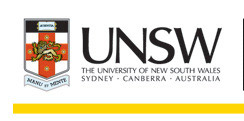Latin Lessons – Latin America and Australia face the Asia Pacific CenturyIntroduction – from competition to collaboration
By Tim Harcourt
Australia and Latin America have been separated by geography, culture and economic ties. Historically, because of their respective colonial ties, Latin America looked to Europe and Australia looked to England, and we’ve been in different hemispheric ‘spheres of influence’ ever since.But things are changing in the 21st century, as Asia and the emerging markets are on the march and Australia and Latin America find they have more in common in the Asia Pacific century than they have had in the past.
Both continents are resources richBoth continents have strong agricultural sectorsBoth rely on immigration in part for their human capitalBoth combine a rich indigenous culture with former colonial institutionsBoth survived the global financial crisis and the subprime crisis largely in tact
Whilst in the 20th century Latin America and Australia were considered to be distant competitors as commodity exporters in the 21st century are now working together through intra-industry investment and technological and management exchange top feed Asia (particularly China) and supply the region with industrial raw materials and professional services. Also we are both looking to collaborate in international economic institutions (like the WTO, APEC and G20).
Latin America and Australia also have strong potential to work together because we share common values like openness, democracy, human rights and the rule of law. In fact it was our democratic Parliamentarians who drove the bilateral relationship and recommend establishing institutions like COALAR to provide policy advice and enhance business engagement. The Parliamentarians also encouraged Australia and Latin America officials to work together and become great allies in multilateral institutions that govern the international economy such as the WTO, APEC and the G20. A classic example is the Cairns Group in the GATT/WTO spearheaded by Australia and the agricultural exporting nations in Latin America and the rest of the emerging world and more recently in the G20.
Following the parliamentarians’ lead, businesses are now looking to form similar relationships and institutions as has been developed in the political sphere. And naturally, our research and academic institutions are looking to complement this with wider and deeper education partnerships and people relationships between Australia and Latin America.
In fact, it is the emphasis put on economic and political institutions that leads Latin America to look to Australia in the first place. Many of my Latin American hosts and guests say that Australia is the place that Latin America could be “if it turns out right.” Whilst younger generations know democracy and relative economic prosperity, those leaders in business, government and community, who have experience of darker times know how economic institutions are contributing to political stability, economic prosperity and social cohesion. And it is Australia’s economic institutions not the sunny beaches and love of sport (that Latin America has already) that explains why many leaders in political, business and community in Latin America aspire to be like Australia.
In this regard, this report has been influenced by two books. Firstly, the work by two Harvard/MIT scholars, Daron Acemoglu and James A. Robinson Why Nations Fail, and secondly, Ian McLean’s excellent economic history of Australia titled Why Australia Prospered. Both works tell us why institutions are so important in determining a nation’s future economic prosperity and political stability.Acemoglu and Robinson basically take a journey of the history of the world to see why some nations have succeeded economically and others have been a disaster even if they had similar endowments of natural resources, climate or historical culture. The central thesis of their argument is that nations who build inclusive and democratic political and economic institutions, will do better economically than nations that don’t. And this doesn’t matter if a nation has an abundance of mineral wealth and natural resources, because if they don’t get the institutions right, with democratic inclusivity, fairness and the protection of property rights so citizens have the incentive to invest, save and innovate, the nation can squander its inheritance.
McLean’s book tracking Australia’s economic history, stems from his historical work comparing lands of recent settlement, in particular, Australia and Argentina (a comparison also made by Acemoglu and Robinson in Why Nations Fail).
A century ago both Argentina and Australia (and Buenos Aires and Melbourne in particular) were two of the richest nations in the world. But whilst Australia developed inclusive institutions and resisted the squattocracy, Argentina allowed land owning oligarchs to flourish, with extractive and exclusive institutions, which forced the mass of the population to support Peronist policies. And this had an adverse impact on the historical development of economic institutions and the eventual economic performance of Argentina relative to Australia, despite both coming from good starting points in the late 19th century.
Even in recent years, at the beginning of the 21st century we can see how economic institutions and their capacity to allow economic reform when external shocks affect an export – orientated country like Argentina and Australia matter.
In fact Australia’s recent economic success is due to the reform of its economic institutions. For example, in opening up to Asia, the Hawke – Keating Government in the 1980s brought fundamental reforms such as the floating of the dollar, reduction of tariff barriers, the introduction of superannuation and undergoing domestic reform. This enabled Australia to prosper in the Asian Century turning our historical ‘tyranny of distance’ position into ‘the power of proximity’.
But as McLean shows, the contrast with Argentina, a similarly resource endowed southern hemisphere economy, couldn’t be greater. Whilst Australia floated the dollar, enabling the economy to have a shock absorber whilst we reformed our economic structures, Argentina fixed the peso to the US dollar, making exports too expensive and imports cheap, which coupled with debt and default, destroyed confidence in Argentina’s institutions and security in their property rights and banking system. Now Argentina knows it needs to rebuild trust and confidence in its institutions, so it can take full advantage of its natural resources and highly educated sophisticated workforce. And that is perhaps why Latin America – particularly Argentina – has been interested in Australia’s institutional story as much as our economic indicators.
Of course, even beyond the study of institutions, when Latin America looks to engage with Australia, it’s also pretty simple as we are an island continent – a continent for a nation and a nation for a continent. But for Australia to look at Latin America, it’s not that simple. Latin America is such a diverse and exciting place that we decided in this report to focus on the key Spanish speaking economies that have potential trade ties with Australia – Mexico, Colombia, Peru, Chile, Argentina and Uruguay after having concentrated solely on Portuguese speaking Brazil in the companion to this report titled: Great Southern Lands – Building ties between Australia and Brazil.
In each chapter a distinguished economist tells the story of their native land – its economy, its society, its political institutions and the potential for forging trade links in the Asia Pacific and with Australia in particular.
The narrative covers trade and commercial links in ‘rocks and crops’ (mining and agriculture), manufacturing, professional services and education, travel and tourism as well as the creative industries.In the first chapter on Mexico, Jose Antonio Ardavin, the Director of the OECD in Mexico City, explains the chequered 19th Century economic history of Mexico complicated by relationship with the USA (which had taken California, Texas, Arizona and New Mexico). He takes us through the recent experience of re-establishing democracy in Mexico in the 2000s, and the impact of NAFTA, the so called ‘tequila crisis of 1994’ and the 2008 global financial crisis stemming from the collapse of Lehman Brothers that hit Mexico particularly hard. But he believes that Mexico has now put that period behind it and in a new spirit of openness, democracy and moderate economic growth, and macroeconomic stability that the world may experience ‘The Mexican Moment.’ But to fulfil its potential, Mexico must he believes undertake serious economic reform in education, human capital, pension reform, energy reform and competition – a process that has since begun under President Pena Neito’s ‘Pact for Mexico’ reforms.
For Australia, along with the bilateral ties in resources, most collaboration comes in education and human capital (strong ties in higher education institutions and technical skills), and Mexico has been studying Australia’s Productivity Commission and other economic institutions. Mexico is a member of the G20 and would be a strong player in the TPP if it were to establish itself in world trade and Mexico and Australia recently joined fellow middle power G20 countries Indonesia, Turkey and South Korea in the MITKA alliance, showing Mexico’s pivotal status in Asia Pacific strategic economic policy.
Mexico’s size and scale has impressed the Australian Ambassador to Mexico Tim George who says: “What has really struck me is Mexico’s significance globally as a major exporter of increasingly sophisticated manufactured goods, its depth of integration into North American supply chains, and its enormous economic potential more broadly. Its sound macro-economic credentials, the outward orientation of its economy, its impressive and far-reaching reform agenda, and its demographics all mean Mexico is on a very good trajectory. It will be a top ten economy before long, and could go significantly higher.”
In Colombia, world renowned academic Mario Garcia-Molina explains the improving economic performance of Colombia that has been overshadowed by its drug cartel and security issues of past decades. The peace dialogues with FARC (the main guerrilla movement) are key to the country’s revival along with major investments in the health system, education and social policies to reduce inequality. Colombia is an enthusiastic member of the Pacific Alliance and APEC and attempting to escape its past and being overly tied to an Andean trade bloc alone. Australian businesses in mining and education have long considered Colombia the Latin American economy with the most potential – given its outstanding reserves of human capital with its cohort of highly educated, sophisticated, services orientated, young people – and the nation has made great strides to improve its National ‘Brand’ status and trade ties in the Asia Pacific.Peru is a classic example of the great improver in the Latin American economic stakes. Pablo de la Flor describes Peru as ‘The Andean Jaguar’ and highlights is strong growth rates (6.4 per cent p.a. on average over the decade), low inflation (averaging 2.5 per cent) and improving per capita income stakes so it reached middle income status like a hiker climbing Macchu Picchu. Peru’s success is a trading story not just within the Andean states and Latin America but also beyond the continent into Asia (China takes 17 per cent of Peru’s exports and trade with Beijing is now more important to Lima than trade with Washington DC). Australia’s contribution to Peru’s success has mainly been in mining but also in agriculture, education and tourism (Macchu Picchu but also Lima’s rise as a gastronomical destination for Australian ‘foodies’). Australian Business Leader Chris Gale, the Managing Director of Latin Resources, has highlighted Peru’s “tremendous upside as a mining country with excellent geology, very user friendly in terms of exploration and the Peruvian government has been more than helpful in terms of green fields and resource definition.”
Peru has also pushed APEC and the Pacific Alliance (being a member along with Chile, Colombia and Mexico). Peru’s main fear is running out of steam after spectacular growth and falling into the ‘middle income trap’ hence its search for new markets in Asia and the Pacific to maintain rising living standards.
Chile has of course been the poster child for Latin American economic performance for many years and kept that reputation as it transformed itself from dictatorship to a fully-fledged democracy after a carefully managed national reconciliation. As Nicolas Munoz of the Foreign Investment Committee of Chile points out, free trade and an open economy has been a cornerstone of Chile’s economic strategy and in many respects Chile has been the model that other aspirational nations in Latin America have been looking to as an example. As Munoz points out Chile is an attractive destination for foreign investors with many Australian companies like BHP Billiton and WorleyParsons basing their Latin American operations in Santiago. But the question for Chile is what next? You can only open your economy once and only negotiate so many free trade agreements with so many countries. In this regard, ‘Red Hot’ Chile is already ahead of the game concentrating on innovation and investment as well as trade, and making Chile a launch pad for innovation into third markets. Hence the work of CSIRO Chile in providing mining and minerals processing technology and training in Santiago and for Peruvian post graduate students in the northern Chilean mining town of Antofagasta. Not to mention the rise of ‘Chilecon Valley’ and other examples of Chilean innovation that is attracting attention (and investment) from Australia.
In the chapter on Argentina, high profile Argentine economist Tomas Bulat explains the role of economic institutions in Argentine history and how economic reform can unleash the potential Argentina has in agriculture, viticulture, human capital and education and even in mining if the institutional framework was improved. Bulat notes the “mood swings” of the Argentine economy but still sees ‘potential for growth’ if Argentina follows a more open economy framework being “respectful of international rules and agreements.”
Of course, many economic historians and scholars like Acemoglu and Robinson and McLean have twinned Argentina and Australia in terms of economic development but what of Argentine-Australian bilateral ties? The Australian Ambassador to Argentina, Patricia Holmes sees potential for Australian-Argentine collaboration and is making higher education ties a priority so future generations of Argentines have exposure and access to Australia in terms of their professional development so they can apply these skills in their home country. Her nominated sectors for further bilateral collaboration are primary industry and related professional services: “The big interest is in investment and the potential of mining services, in agriculture its technology, water management and genetics.”
Finally, in the chapter on Uruguay, Mariana Ferreira Head of the Competitive Intelligence Unit of Uruguay XXI, tells the economic story of a nation whose geography seemed to work against its economics, particularly at the turn of the 21st century when its giant neighbours Brazil suffered a devaluation (in 1999) and Argentina and overall economic crisis (in 2002). But despite this setback early in the new millennium Uruguay has recovered with a respectable 6 per cent growth rate (between 2005 and 2012) and reasonable fiscal and monetary policy management. Uruguay is an export orientated open economy but with most of its foreign investment stemming from neighbours Brazil and Argentina, the USA and Europe rather than Australia and the Asia Pacific. Had Uruguay been able to be more like Chile and not hemmed in by Mercosur (the trade pact with Brazil, Argentina, Paraguay and now Venezuela) its trade and investment story could have been much different. However as the author says Uruguay is a ‘plucky’ or ‘maverick’ country and has moved fast in terms of social reform under its colourful but frugal President. Progress in social issues, in health and education, family arrangements and reducing the digital divide has been prominent. The strong interest in Public Private Sector Partnerships (PPP) has attracted interest and guidance from Australia as Uruguay attempts to balance economic prosperity and social cohesion in how it develops its national infrastructure assets. Ricardo Varela, Uruguay’s Ambassador to Australia has highlighted resources and agriculture as potential areas for bilateral collaboration: “Globalization is bringing our regions closer. Uruguay is starting some mining activities, which has brought new opportunities to do business and exchange experiences. Both countries need to feed the world, and by sharing this responsibility we shall work together.”
What is apparent after looking at each economy in detail is that there are different challenges facing Latin America in terms of political economy. There are the open economies of Mexico, Chile, Peru and Colombia that have formed the Pacific Alliance and are signing trade agreements with Asia and each other to spread the benefits of trade and investment to their population to improve living standards. Then there are more closed economies like Argentina who are more interventionist and populist running positions closer to Venezuela. Then there is Uruguay who given its open agricultural sector perhaps could be more like a Pacific Alliance country but is constrained by being tied to its larger neighbours Brazil and Argentina via the Mercosur trade pact. Accordingly, could Uruguay combine the strong social justice focussed policies of its President with the open economy model of its Pacific Alliance partners? Overall, the report’s co-authors are cautiously optimistic about the forging of stronger ties between Australia and Latin America particularly as the Asia Pacific region becomes more influential in the global economy and international political institutions. And just as we economists have collaborated to produce this report on Latin America and Australia in the Asia Pacific century, we hope our respective nations can do the same thing in terms of trade and in terms of people in years to come.We hope this is a sound start along that journey.













No Comments so far ↓
Comments are closed.